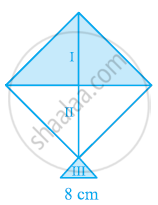Advertisements
Advertisements
Question
If each side of a triangle is doubled, the find percentage increase in its area.
Solution
The area of a triangle having sides a, b, c and s as semi-perimeter is given by,
`A = sqrt(s(s-a)(s-b)(s-c))`
Where,
`s = (a+b+c)/2`
`2s = a+b+c`
We take the sides of a new triangle as 2a, 2b, 2c that is twice the sides of previous one
Now, the area of a triangle having sides 2a, 2b, and 2c and s1 as semi-perimeter is given by,
`A_1= sqrt(s_1(s_1-2a)(s_1-2b)(s_1-2c))`
Where,
`s_1 = (2a+2b+2c)/2`
`s_1 = (2(a+b+c))/2`
s1 = a+ b+ c
s1 = 2s
Now,
`A_1 = sqrt(2s (2s-2a)(2s-2b)(2s-2c))`
`A_1 = sqrt(2s xx 2 (s-a) xx 2 (s-b) xx 2 (s-c))`
`A_1 = 4 sqrt(s(s-a)(s-b)(s-c))`
`A_1 = 4A`
Therefore, increase in the area of the triangle
=A1 -A
=4A-A
=3A
Percentage increase in area
`=(3A)/A xx 100 `
= 300%
APPEARS IN
RELATED QUESTIONS
A triangle and a parallelogram have the same base and the same area. If the sides of triangle are 26 cm, 28 cm and 30 cm, and the parallelogram stands on the base 28 cm, find the height of the parallelogram.
A kite in the shape of a square with a diagonal 32 cm and an isosceles triangles of base 8 cm and sides 6 cm each is to be made of three different shades as shown in the given figure. How much paper of each shade has been used in it?

Find the area of an equilateral triangle having each side x cm.
The sides of a triangle are 11 cm, 15 cm and 16 cm. The altitude to the largest side is
The base and hypotenuse of a right triangle are respectively 5 cm and 13 cm long. Its area is
If every side of a triangle is doubled, then increase in the area of the triangle is
Find the area of a quadrilateral ABCD whose sides are AB = 13 cm, BC = 12 cm, CD = 9 cm, AD = 14 cm and diagonal BD = 15 cm
A park is in the shape of a quadrilateral. The sides of the park are 15 m, 20 m, 26 m and 17 m and the angle between the first two sides is a right angle. Find the area of the park
The adjacent sides of a parallelogram measures 34 m, 20 m and the measure of the diagonal is 42 m. Find the area of parallelogram
The area of a regular hexagon of side ‘a’ is the sum of the areas of the five equilateral triangles with side a.
